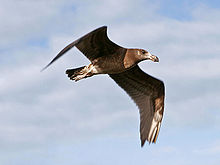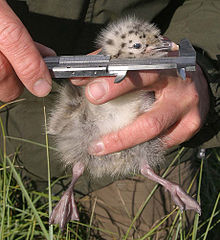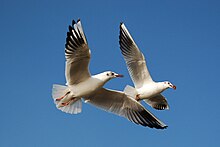Seagulls
| Seagulls | ||||||||||||
|---|---|---|---|---|---|---|---|---|---|---|---|---|

Mediterranean seagull ( Larus michahellis ) |
||||||||||||
| Systematics | ||||||||||||
|
||||||||||||
| Scientific name | ||||||||||||
| Larinae | ||||||||||||
| Vigors , 1825 |



The gulls (Larinae) until 1901 gulls , form a subfamily within the order of Regenpfeiferartigen or waders and gulls birds (Charadriiformes).
features
Appearance
Seagulls are medium to large birds. They have relatively long and narrow, pointed wings and strong, slender beaks with a slightly downwardly curved upper beak. The three forward-facing toes are webbed, a fourth, very short, toe pointing backwards or absent in some species.
Seagulls are usually white-gray pinnate, often with black coloring on the head, back and wings. The sexes do not differ in color, but the males are slightly larger. In many species the young birds are brownish in color. The larger gull species need up to four years to fully color, with the smaller species two years are normal. Many species have different breeding and resting clothes. Species with a dark head color in the breeding plumage lose these in the dormant plumage and then only have a few dark spots on the head and neck.
voice
Seagulls are quite vocal birds, which is often compounded by their sociable demeanor. Their screams are often uttered in a row.
distribution
Seagulls are found almost all over the world, most of them species-rich in the temperate and cold climates of both hemispheres. In many tropical regions there is a lack of breeding occurrences, for example in the Amazon Basin in South America , in the Congo Basin in Central Africa , in India , Southeast Asia and New Guinea . However, some species that breed in the north come to the coasts to overwinter.
habitat
Most species of seagulls live on the coasts. Some species, such as the black-headed gull , also breed inland, especially in larger bodies of water. Few, like the kittiwake , live on the high seas for most of the year. Some species, for example the herring gull , have become culture followers and populate garbage dumps, sewage ponds and fish processing companies, especially in winter.
Way of life
Seagulls are excellent glider pilots, especially in strong winds. They mainly search the beach for food and sometimes hunt other birds for prey. When diving for food, only the head and part of the body are underwater.
nutrition
Most species of seagulls are omnivorous and eat live food or waste and carrion depending on the occasion. However, animal foods such as fish , crustaceans , molluscs or echinoderms predominate , and occasionally small rodents . The large species, such as the black-headed gull ( Larus marinus ), also rob nests and even prey on birds up to the size of ducks , mainly killing sick animals. In contrast, the smaller species, such as the black-headed gull , prefer to stick to insects and worms .
Seagulls partially meet their hydration needs by drinking sea water. They collect the excess salt by means of salt glands placed in pairs in the area of the upper front of the skull and excrete it again via the nostrils. Species that are found in extremely saline waters, such as the California gull , seek nearby freshwater sources to drink and prefer food with a high water content. In some species, such as the prairie gull , which breed on inland lakes, the salt glands have receded and only become functional before the migration time, when the birds move into maritime habitats.
Reproduction and development

The seagulls are ground breeders. Some species specialize in nesting in rock niches. Seagulls usually breed in colonies. They usually lay 2–4 eggs in nests, which they defend aggressively, including against humans. The eggs are incubated alternately by both parents for 3–5 weeks. The chicks can run and swim right from the start, but usually remain seated in the nest as nestlings and are fed by both parents. It takes 3–9 weeks for small species such as the little gull ( L. minutus ) to fledge than it does for large species such as the black-headed gull.
Seagulls can live to be around 30 years old.
Systematics
When narrowly delimited or according to the conventional view, the subfamily comprises around 55 species . So far they have been divided into 7 genera , but most species are placed in the genus Larus . According to recent studies of mitochondrial DNA , this taxon is paraphyletic . According to the recommendation of the authors, either all species should therefore be placed in the aforementioned genus, or these should be divided into various others, so that for the 55 species mentioned there are between 10 and 11 genera.
The taxonomy of the kinship group around herring gull and black-backed gull ( Larus fuscus ) is very difficult. This group consists of 2–8 species, depending on the opinion, and has an annular distribution around the northern hemisphere . Spatially adjoining clans are sometimes only incompletely genetically isolated, so that there is a certain gene flow between them.
Genera and species


The following list follows the World Bird List of the International Ornithological Congress . This includes findings regarding mitochondrial DNA published in 2005. The authors' recommendations were largely followed. However, some suggestions, such as a separate genus Saundersilarus for the Cape Gull or a common genus for the Little and Rose Gulls, have not yet been considered.
Genus Chroicocephalus
- Brown- headed gull ( Chroicocephalus brunnicephalus )
- Maori gull ( Chroicocephalus bulleri )
- Gray-headed Gull ( Chroicocephalus cirrocephalus )
- Hard-leaved gull ( Chroicocephalus hartlaubii )
- Thin-billed gull ( Chroicocephalus genei )
- Patagonian gull ( Chroicocephalus maculipennis )
- Bonaparte gull ( Chroicocephalus philadelphia )
- Black-headed gull ( Chroicocephalus ridibundus )
- Cape gull ( Chroicocephalus saundersi )
- Red-billed gull ( Chroicocephalus scopulinus )
- Andean gull ( Chroicocephalus serranus )
- Herring-headed gull ( Chroicocephalus novaehollandiae )
Genus Creagrus
- Fork-tailed gull ( Creagrus furcatus )
Genus Hydrocoloeus
- Little Gull ( Hydrocoloeus minutus )
Genus Ichthyaetus
- Coral gull ( Ichthyaetus audouinii )
- Hemprich's gull ( Ichthyaetus hemprichii )
- Fish gull ( Ichthyaetus ichthyaetus )
- White-eyed gull ( Ichthyaetus leucophthalmus )
- Black- headed Gull ( Ichthyaetus melanocephalus )
- Relic Gull ( Ichthyaetus relictus )
Genus Larus
- Herring gull ( Larus argentatus )
- Armenian Gull ( Larus armenicus )
- Olroggull ( Larus atlanticus )
- Simeon's gull ( Larus belcheri )
- Steppe gull ( Larus cachinnans )
- Californian gull ( Larus californicus )
- Common Gull ( Larus canus )
- Japanese gull ( Larus crassirostris )
- Ring- billed gull ( Larus delawarensis )
- Dominican gull ( Larus dominicanus )
- Lesser black-backed gull ( Larus fuscus )
- Bering Gull ( Larus glaucescens )
- Iceland Gull ( Larus glaucoides )
- Common gull ( Larus heermanni )
- Ice gull ( Larus hyperboreus )
- Yellow-legged gull ( Larus livens )
- Black-headed gull ( Larus marinus )
- Mediterranean seagull ( Larus michahellis )
- Western gull ( Larus occidentalis )
- Black-billed Gull ( Larus pacificus )
- Kamchatka Gull ( Larus schistisagus )
- American herring gull ( Larus smithsonianus )
- Thayer gull ( Larus thayeri )
- Eastern Siberian Gull ( Larus vegae )
Genus Leucophaeus
- Aztec Gull ( Leucophaeus atricilla )
- Lava gull ( Leucophaeus fuliginosus )
- Gray gull ( Leucophaeus modestus )
- Prairie gull ( Leucophaeus pipixcan )
- Dolphin gull ( Leucophaeus scoresbii )
Genus Rissa
Genus Rhodostethia
- Rose Gull ( Rhodostethia rosea )
Genus Pagophila
- Ivory Gull ( Pagophila eburnea )
Genus Xema
- Swallow Gull ( Xema sabini )
Originally the gulls had the rank of an independent family (Laridae) within the order of the plover-like (Charadriiformes). According to molecular genetic data, the closely related terns in their old composition are not a monophyletic taxon, but are divided into three clades and, together with the gulls and scissors beaks, form a larger clade. Noddiseeschwalben (Anoinae) and White Fairy Terns (Gyginae) have therefore been spun off from the terns and together with the gulls and scissors beaks (Rhynchopinae) all the three groups as subfamilies in an extended family Laridae provided, the gulls now have only the status of a subfamily.
literature
- J.-M. Pons, A. Hassanin, P.-A. Crochet: Phylogenetic relationships within the Laridae (Charadriiformes: Aves) inferred from mitochondrial markers . Molecular Phylogenetics and Evolution, Volume 37, Issue 3, December 2005, pages 686-699 doi : 10.1016 / j.ympev.2005.05.011
- Klaus Malling Olsen, Hans Larsson: Gulls of Europe, Asia and North America , Helm Identification Guides, Christopher Helm, London 2003 (corrected new edition from 2004), ISBN 978-0-7136-7087-5
- Urs N. Glutz von Blotzheim , KM Bauer : Handbook of the birds of Central Europe . Volume 8 / I: Charadriiformes. 3rd part: snipe, gull and alken birds. AULA-Verlag, ISBN 3-923527-00-4 .
supporting documents
- ↑ Ralf Wassmann: Ornithological Pocket Lexicon . AULA-Verlag, Wiesbaden, 1999. ISBN 3-89104-627-8
- ↑ Josep del Hoyo, Andrew Elliott, Jordi Sargatal (eds.): Handbook of the Birds of the World . Volume 3: Hoatzin to Auks. Lynx Edicions 1996, ISBN 978-84-87334-20-7 , pp. 575f
- ↑ Pons et al. (2005), see literature
- ↑ www.worldbirdnames.org
- ↑ Baker, AJ; Pereira, SL; Paton, TA (2007). Phylogenetic relationships and divergence times of Charadriiformes genera: multigene evidence for the Cretaceous origin of at least 14 clades of shorebirds. Biology Letters. 3: 205-209. doi: 10.1098 / rsbl.2006.0606
- ↑ David W. Winkler, Shawn M. Billerman, Irby J. Lovette: Bird Families of the World: A Guide to the Spectacular Diversity of Birds. Lynx Edicions (2015), ISBN 978-8494189203 . Pages 149–151.
- ^ IOC World Bird List: Noddies, gulls, terns, auks
Web links
- Tree of Life Web Project. 2008. Laridae. Gulls, terns, skimmers. Version June 24, 2008. in The Tree of Life Web Project
- Bird Families of the World - Gulls Larinae.






